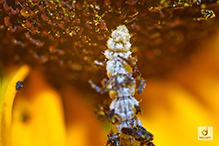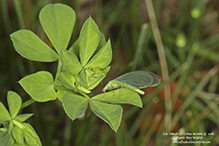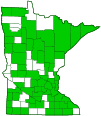green lacewings
(family Chrysopidae)
Overview • Description • Distribution • Taxonomy
Description |
Green lacewings, as the name suggests, are usually green. The bodies are long, slender, and usually bright green to greenish brown. Some are brown, especially overwintering adults of some Chrysoperla species. The eyes are golden or copper colored. The forewings are usually greenish, translucent, and slightly iridescent, and they have many veins and crossveins. The costal field, the area between the costal vein (C) on the leading edge of the wing and the second longitudinal vein, the subcostal vein (Sc), is wide and crossed by many unforked crossveins. The first undivided branch of the radial vein (R1) and the Sc vein are not fused at the wingtip. The second branch of the radial vein (Rs) is unbranched or at least appears to be unbranched. The wing appears hairless, but short hairs on the margins and on the veins can be seen under magnification. The larvae of some species appear humpbacked, with a prominent bulge on the thorax. Others have long bristles on their sides that collect debris, including the remains of aphids they have eaten. This is thought to be a form of camouflage, protecting them from birds. |
Distribution |
||
|
Sources Biodiversity occurrence data published by: Minnesota Biodiversity Atlas (accessed through the Minnesota Biodiversity Atlas Portal, bellatlas.umn.edu, XX/XX/XXXX). |
|
| 8/9/2025 | ||
Occurrence |
||
Common |
||
Taxonomy |
|
Order |
Neuroptera (antlions, lacewings, and allies) |
Suborder |
Hemerobiiformia (lacewings and allies) |
Subordinate Taxa |
|
apochrysine green lacewings (subfamily Apochrysinae) basal green lacewings (subfamily Nothochrysinae) typical green lacewings (subfamily Chrysopinae) |
|
Synonyms |
|
|
|
Common Names |
|
green lacewings |
|
Visitor Photos |
||
Share your photo of this insect. |
||
This button not working for you? |
||
Mike Poeppe |
 |
Alfredo Colon |
 |
MinnesotaSeasons.com Photos |
||
|
||
|
||

Visitor Videos |
||
Share your video of this insect. |
||
This button not working for you? |
||
|
Other Videos |
||
Green Lacewing (Chrysopidae: Chrysoperla) Grooming after Eating |
About
Jun 10, 2010 Photographed at Grand Forks, North Dakota (09 June 2010). |
Green Lacewing (Chrysopidae: Chrysopa oculata) on Wall |
About
Aug 15, 2010 Photographed near Fisher, Minnesota (14 August 2010). |
Macro - Lacewings (Chrysopidae) |
About
Dec 1, 2018 |

Visitor Sightings |
||
Report a sighting of this insect. |
||
This button not working for you? |
||
Mike Poeppe |
Location: near Houston, MN |
 |
Mike French |
Location: Milford Township, Brown County |
|
| Alfredo Colon 7/15/2018 |
Location: Woodbury, Minnesota |
 |
MinnesotaSeasons.com Sightings |
||
|

Created: 10/28/2019 Last Updated: © MinnesotaSeasons.com. All rights reserved. |


